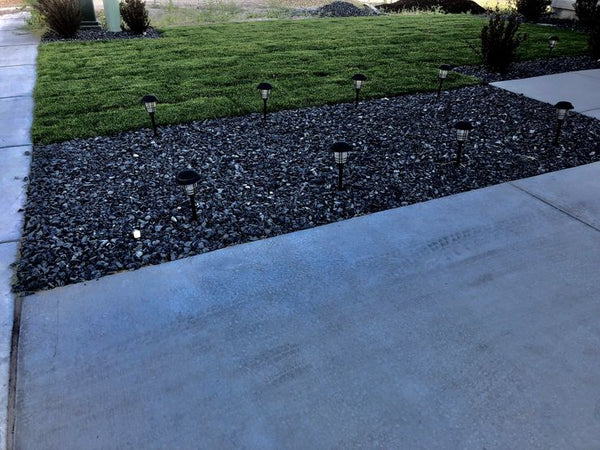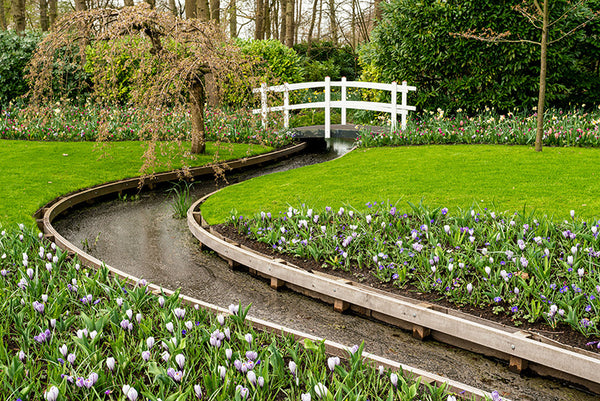Have you noticed that water levels are down? Regular landscapes require a great deal of that precious natural resource, but there is good news: xeriscaping is a colorful and attractive alternative that can save water.
Xeriscape is not the same as zeroscape, in that it does include plants, trees, shrubs, and turf. You can design a gorgeous yard, and still conserve water. We are going to get into the seven components of a well-planned xeriscape design.
Design Planning Is the First Of Seven Keys To A Successful Xeriscaped Yard
Before you move a single wheelbarrow of mulch, you need a great design. In the same way that you create an outline before you write a paper, you need to plan your design in order to have a xeriscaped yard that you and your family will love.
At this step in the process, you should consider the slope of your property, which areas get the most sun, where to store water and compost, and how to store your yard tools. Do not skip this step! You know what they say; If you fail to plan, you plan to fail.
Soil Type Is Critical To Any Xeriscaped Space
While it may seem like there are hundreds of different types or classes for soil, they can all be broken down into three basic categories: clay-based soils, silt which does not hold moisture well but does absorb water when wet; and sand in between these two extremes.
To figure out if you need to add organic matter to the soil on your property just look at what type is present! You can order a home soil test for less than $50. This test will tell you what you are working with, and what you need to optimize your soil. Organic materials will help improve drainage while retaining more solar energy than traditional technologies such as irrigation systems do--which means less work maintaining them year-round.
Drought Resistant Trees, Plants, Shrubs, And Turf Will Ensure That Your Xeriscape Is Healthy And Thriving, Even When The Water Levels Are Low
There are many resources online to find plants that will thrive in our climate. A local nursery is also a great resource. A few of the most popular options for xeriscape are:
- Fringed Sagebrush
- Smooth Sumac
- Moonshine Yarrow
- Blue Flax
- Flame Amur Maple
- Bosnian Redcone Pine
- Bur Oak
- Regent Service Berry
- Blue Star Juniper
- Creeping Oregon Grape
- Red Creeping Thyme
By choosing shrubs and plants with varying heights, colors, and textures, you will richly enhance the effect of your xeriscape design. Remember to group plants by water needs.
Xeriscape Does Not Eliminate Turf, But Rather Utilizes It In Strategic Ways To Maximize The Enjoyment Of Your Yard
There are several varieties of turf that can be used in your xeriscape. Your plan should include 20 - 30% turf and should be located in areas of your design that will provide the most practical benefit. Turf is terrific for children to play on, and for animals to frolic on when they are outdoors. Including turf in your design will ensure that your yard is enjoyed to the fullest, and becomes a source of year-round gratification.
Some ideal types of turf for Northern Utah are:
- Marco Polo
- Bighorn
- Audubon
- Iverness
- Florentine
- Garnet
- Dawson
- Aruba
- Tiffany
- Winward
Mulch Is Not Just The Finishing Touch Of Your Xeriscape; It Is Also Critical In Impacting Your Water Usage
Mulch comes in two basic varieties: gravel and organic. If you have spent any time at all perusing the annals of ground cover options available online, you know that beyond those two simple-sounding options, there are many choices that impact the aesthetics of your yard.
Even more important than the visual appeal of your mulch is the way that it can affect and improve your watering efforts. Gravel and rock mulch will retain heat, causing water to evaporate more quickly. Due to its weight and heat retaining properties, gravel is a better choice for hardier plants, trees and shrubs.
Also, due to gravel's non-porous properties, water will tend to run off quickly. Organic mulch will retain water and is more suitable for your delicate plants, and those that need more water.
Now That You’ve Laid A Foundation, The Final Pieces Are Irrigation And Maintenance
You want to make sure that you water enough, but not too much. Most of your plants will require ½” to 1” of water. Remember to place your thirstier plants closer to your water source. You may also consider collecting rainwater. In Utah, you can collect up to 2,500 gallons of water per year.
You will also want to water your turf separately from your other plants and trees. Planning your irrigation in zones will make that possible. Although xeriscape is lower maintenance than your standard landscape, it is not maintenance-free. Plan on annual pruning, fertilizing, and deadheading. Watering, weeding, and mowing will still need to be done 2-3 times a week.
There are lots of options for landscaping in Northern Utah. A wide variety of plants, trees, and shrubs will thrive in Utah, but some are much more water-dependent than others. As water is a precious resource that we need to protect and conserve, considering low water options for your yard is good for you and good for your community.
Xeriscape is a low water landscape option that is also beautiful, hearty, and easy to maintain. The materials are eco-friendly and sustainable. In Utah, we have a wide variety of plants, trees, shrubs, and turf to choose from. However, getting the materials to finish your project can prove challenging. The gravel, rocks, mulch, fertilizer, and soil add-ins can be difficult to transport.



